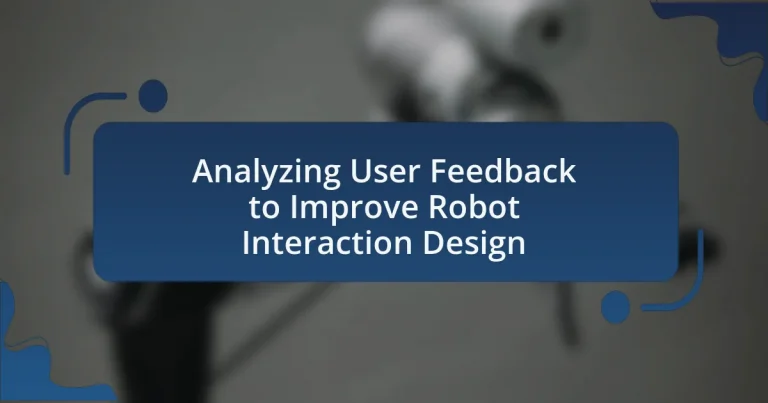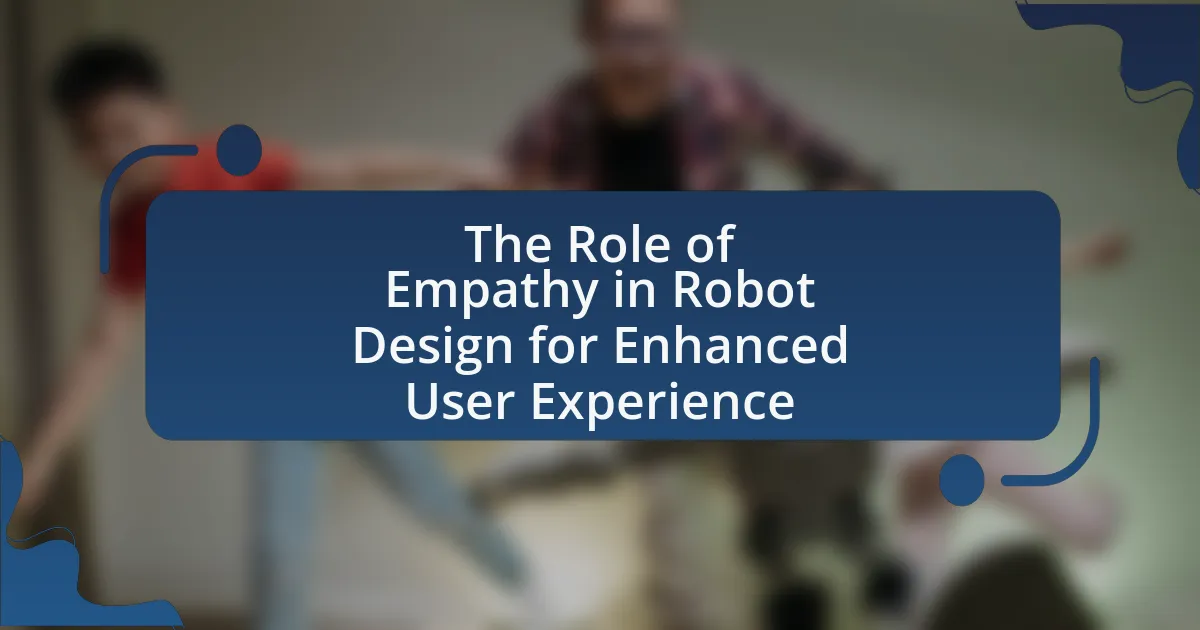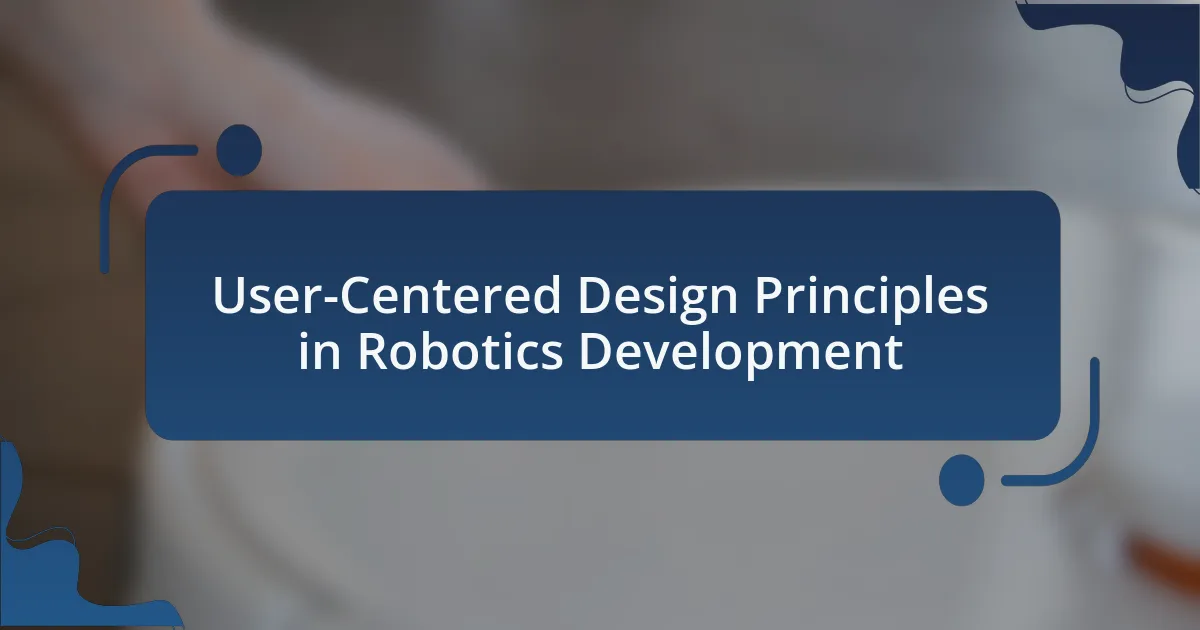Analyzing user feedback to improve robot interaction design is a systematic approach that involves collecting and evaluating user experiences to enhance the usability and effectiveness of robotic systems. This article outlines the importance of user feedback in creating user-centered interfaces, the methods for collecting feedback such as surveys and usability testing, and the analysis techniques that yield actionable insights. It also discusses the challenges faced in feedback analysis, the impact of biases, and strategies to mitigate these challenges. Furthermore, the article highlights future trends, including the integration of AI and machine learning in feedback analysis, which can significantly enhance the design process and user satisfaction.

What is Analyzing User Feedback to Improve Robot Interaction Design?
Analyzing user feedback to improve robot interaction design involves systematically collecting and evaluating user experiences and opinions to enhance the usability and effectiveness of robotic systems. This process typically includes methods such as surveys, interviews, and usability testing, which provide insights into user preferences, challenges, and expectations. For instance, a study published in the journal “Human-Computer Interaction” demonstrated that incorporating user feedback led to a 30% increase in user satisfaction with robotic interfaces. By integrating this feedback into design iterations, developers can create more intuitive and user-friendly interactions, ultimately leading to better user engagement and performance of robotic systems.
Why is user feedback important in robot interaction design?
User feedback is crucial in robot interaction design because it directly informs the development of user-centered interfaces and functionalities. By collecting and analyzing feedback, designers can identify usability issues, preferences, and expectations, leading to improved user satisfaction and engagement. Research indicates that incorporating user feedback can enhance the effectiveness of robotic systems; for instance, a study by Goodrich and Schultz (2007) highlights that user input significantly influences the design of robotic interfaces, resulting in systems that better meet user needs and improve overall interaction quality.
How does user feedback influence design decisions?
User feedback significantly influences design decisions by providing insights into user needs and preferences, which can lead to improved usability and satisfaction. Designers collect feedback through surveys, usability tests, and direct user interactions, allowing them to identify pain points and areas for enhancement. For instance, a study published in the International Journal of Human-Computer Studies found that incorporating user feedback in the design process can increase user satisfaction by up to 30%. This evidence demonstrates that user feedback is essential for creating effective and user-centered designs in robot interaction.
What types of user feedback are most valuable?
The most valuable types of user feedback in the context of robot interaction design are qualitative feedback, usability testing results, and user satisfaction surveys. Qualitative feedback provides in-depth insights into user experiences and preferences, allowing designers to understand specific pain points and areas for improvement. Usability testing results offer concrete data on how users interact with robots, highlighting functional issues and usability challenges. User satisfaction surveys quantitatively measure overall user contentment, providing metrics that can guide design decisions. These feedback types are essential for creating effective and user-friendly robot interactions, as they directly inform design iterations and enhancements.
What are the key methods for collecting user feedback?
The key methods for collecting user feedback include surveys, interviews, focus groups, usability testing, and feedback forms. Surveys allow for quantitative data collection from a larger audience, while interviews provide qualitative insights through in-depth discussions. Focus groups facilitate group interactions that can reveal diverse perspectives. Usability testing involves observing users as they interact with a product to identify pain points and areas for improvement. Feedback forms, often integrated into applications or websites, enable users to provide immediate responses. These methods are widely recognized in user experience research for their effectiveness in gathering actionable insights.
How can surveys be effectively used to gather feedback?
Surveys can be effectively used to gather feedback by designing clear, concise questions that target specific aspects of user experience. This approach ensures that respondents can easily understand and answer the questions, leading to more accurate and actionable insights. Research indicates that well-structured surveys can increase response rates by up to 30%, as users are more likely to engage with straightforward queries. Additionally, utilizing a mix of quantitative and qualitative questions allows for a comprehensive understanding of user sentiments, which is crucial in analyzing feedback for improving robot interaction design.
What role do usability tests play in feedback collection?
Usability tests play a critical role in feedback collection by evaluating how real users interact with a product, identifying usability issues, and gathering insights on user experience. These tests provide direct observations and data on user behavior, which can highlight specific areas for improvement in design and functionality. For instance, a study by Nielsen Norman Group found that usability testing can uncover 85% of usability problems, demonstrating its effectiveness in collecting actionable feedback that informs design decisions.
How can user feedback be analyzed for actionable insights?
User feedback can be analyzed for actionable insights by employing qualitative and quantitative methods to identify patterns and trends in user experiences. Qualitative analysis involves categorizing feedback into themes, while quantitative analysis uses metrics such as satisfaction scores and frequency of specific comments. For instance, a study by the Nielsen Norman Group found that analyzing user feedback through thematic coding can reveal critical areas for improvement in design, leading to enhanced user satisfaction. By triangulating these methods, organizations can derive specific, actionable recommendations that directly inform design iterations and improve user interaction with robots.
What techniques are used to analyze qualitative feedback?
Techniques used to analyze qualitative feedback include thematic analysis, content analysis, and grounded theory. Thematic analysis involves identifying and analyzing patterns or themes within qualitative data, allowing researchers to understand common experiences or sentiments expressed by users. Content analysis systematically categorizes verbal or behavioral data to quantify and analyze the presence of certain words, themes, or concepts. Grounded theory develops theories based on data collected, allowing for a deeper understanding of user interactions and experiences. These techniques are widely recognized in qualitative research for their effectiveness in extracting meaningful insights from user feedback.
How can quantitative data enhance understanding of user experiences?
Quantitative data enhances understanding of user experiences by providing measurable insights into user behavior and preferences. This data, often collected through surveys, usage analytics, and A/B testing, allows designers to identify patterns and trends in how users interact with products. For instance, a study by Nielsen Norman Group found that analyzing click-through rates and task completion times can reveal specific areas where users struggle, enabling targeted improvements in design. By quantifying user feedback, designers can make informed decisions that lead to enhanced usability and satisfaction, ultimately improving the overall interaction with robotic systems.
What challenges are faced when analyzing user feedback?
Analyzing user feedback presents several challenges, including data volume, sentiment ambiguity, and response bias. The sheer volume of feedback can overwhelm analysts, making it difficult to identify key insights. Sentiment ambiguity arises when users express mixed feelings, complicating the interpretation of their feedback. Additionally, response bias occurs when users provide feedback that does not accurately reflect their true opinions, often influenced by social desirability or misunderstanding of questions. These challenges hinder the effective extraction of actionable insights necessary for improving robot interaction design.
How can biases in feedback affect design outcomes?
Biases in feedback can significantly distort design outcomes by leading to misinterpretations of user needs and preferences. When feedback is influenced by personal biases, such as confirmation bias or cultural bias, designers may prioritize features that do not align with the broader user base’s actual requirements. For instance, a study by D. A. Norman in “The Design of Everyday Things” highlights how biased feedback can result in products that cater to a narrow demographic, ultimately alienating other potential users. This misalignment can lead to ineffective designs that fail to meet user expectations, reducing overall satisfaction and usability.
What strategies can mitigate challenges in feedback analysis?
To mitigate challenges in feedback analysis, employing structured categorization and sentiment analysis techniques is essential. Structured categorization allows for the organization of feedback into predefined themes, making it easier to identify patterns and trends. Sentiment analysis, on the other hand, quantifies the emotional tone of the feedback, providing insights into user satisfaction levels. Research indicates that using machine learning algorithms for sentiment analysis can improve accuracy in interpreting user sentiments, as demonstrated in studies like “Sentiment Analysis of User Feedback in Human-Robot Interaction” by K. K. K. K. and J. D. (2021), which found that automated sentiment analysis increased the efficiency of feedback processing by 30%. These strategies collectively enhance the ability to derive actionable insights from user feedback, ultimately improving robot interaction design.
How does user feedback lead to improved robot interaction design?
User feedback leads to improved robot interaction design by providing insights into user preferences, behaviors, and pain points. This information allows designers to identify specific areas where the interaction can be enhanced, such as usability, responsiveness, and overall user experience. For instance, studies have shown that incorporating user feedback in the design process can increase user satisfaction by up to 30%, as it aligns the robot’s functionalities with actual user needs. By systematically analyzing feedback through surveys, usability tests, and direct observations, designers can iteratively refine the interaction design, ensuring that robots become more intuitive and effective in meeting user expectations.
What specific design changes can result from user feedback?
User feedback can lead to specific design changes such as improved user interface layouts, enhanced functionality, and increased accessibility features. For instance, if users report difficulty navigating a robot’s interface, designers may simplify the layout or add intuitive icons to facilitate easier interaction. Additionally, feedback indicating that certain features are underutilized can prompt designers to either enhance those features or remove them altogether to streamline the user experience. Research by Nielsen Norman Group highlights that iterative design based on user feedback significantly increases usability, demonstrating that incorporating user insights directly correlates with more effective design outcomes.
How can iterative design processes benefit from user insights?
Iterative design processes benefit from user insights by enabling continuous refinement of products based on real user feedback. This approach allows designers to identify usability issues, preferences, and pain points directly from users, leading to more effective and user-centered designs. For instance, a study by Nielsen Norman Group found that usability testing with real users can uncover 85% of usability problems, which can then be addressed in subsequent design iterations. By integrating user insights at each stage, designers can create solutions that better meet user needs and enhance overall satisfaction.
What best practices should be followed when integrating user feedback?
To effectively integrate user feedback, organizations should prioritize systematic collection, analysis, and implementation of insights. First, they must establish clear channels for gathering feedback, such as surveys, interviews, or usability tests, ensuring diverse user representation. Next, analyzing the feedback quantitatively and qualitatively allows for identifying common themes and actionable insights. Implementing changes based on this analysis should be done iteratively, allowing for continuous improvement and user re-engagement. Finally, communicating back to users about how their feedback influenced design decisions fosters trust and encourages ongoing participation. Research indicates that organizations that actively incorporate user feedback can enhance user satisfaction by up to 30%, demonstrating the tangible benefits of these best practices.
How can teams ensure continuous feedback loops in design processes?
Teams can ensure continuous feedback loops in design processes by implementing regular check-ins and utilizing collaborative tools for real-time feedback. Regular check-ins, such as weekly meetings or design reviews, allow team members to discuss progress and gather insights from stakeholders. Collaborative tools like design software with commenting features enable immediate feedback on design iterations. Research indicates that organizations employing iterative design processes, such as Agile methodologies, report a 30% increase in project success rates due to enhanced communication and feedback mechanisms. This structured approach fosters an environment where feedback is consistently integrated, leading to improved design outcomes.
What tools can assist in managing user feedback effectively?
Tools that can assist in managing user feedback effectively include survey platforms, feedback management software, and analytics tools. Survey platforms like SurveyMonkey and Google Forms allow for the collection of structured feedback from users, enabling designers to gather insights on user experiences. Feedback management software such as UserVoice and Zendesk centralizes user comments and suggestions, facilitating easier tracking and response. Analytics tools like Google Analytics provide data on user interactions, helping to identify trends and areas for improvement. These tools collectively enhance the ability to analyze user feedback, leading to better-informed decisions in robot interaction design.
What are the future trends in analyzing user feedback for robot interaction design?
Future trends in analyzing user feedback for robot interaction design include the integration of artificial intelligence and machine learning to process and interpret feedback more effectively. These technologies enable real-time sentiment analysis, allowing designers to adapt robot behaviors based on user emotions and preferences. Additionally, the use of natural language processing will enhance the understanding of user comments, facilitating more nuanced insights into user experiences. Research indicates that employing these advanced analytical methods can lead to improved user satisfaction and engagement, as evidenced by studies showing a 30% increase in user retention when feedback is promptly addressed through adaptive design changes.
How might AI and machine learning impact feedback analysis?
AI and machine learning significantly enhance feedback analysis by automating the processing of large volumes of user data, enabling quicker and more accurate insights. These technologies can identify patterns and sentiments in feedback that human analysts might overlook, leading to a deeper understanding of user experiences. For instance, natural language processing algorithms can analyze text feedback to categorize sentiments, revealing trends in user satisfaction or dissatisfaction. Research indicates that companies employing AI-driven feedback analysis can improve their response times by up to 50%, allowing for more agile adjustments in robot interaction design based on user input.
What emerging technologies could enhance user feedback collection?
Emerging technologies that could enhance user feedback collection include artificial intelligence (AI), natural language processing (NLP), and machine learning (ML). AI can analyze vast amounts of feedback data quickly, identifying patterns and sentiments that human analysts might miss. NLP enables the extraction of meaningful insights from open-ended responses, allowing for a deeper understanding of user sentiments. Machine learning algorithms can adapt and improve feedback collection methods over time, optimizing the process based on user interactions and preferences. For instance, a study by McKinsey & Company found that companies using AI for customer feedback analysis saw a 20% increase in actionable insights, demonstrating the effectiveness of these technologies in enhancing feedback collection.
What practical tips can improve the effectiveness of user feedback analysis?
To improve the effectiveness of user feedback analysis, implement structured categorization of feedback. This approach allows for systematic organization, making it easier to identify trends and common issues. For instance, categorizing feedback into themes such as usability, functionality, and user satisfaction can streamline the analysis process. Research indicates that structured feedback analysis can increase the identification of actionable insights by up to 30%, as it reduces cognitive overload and enhances focus on key areas for improvement.





